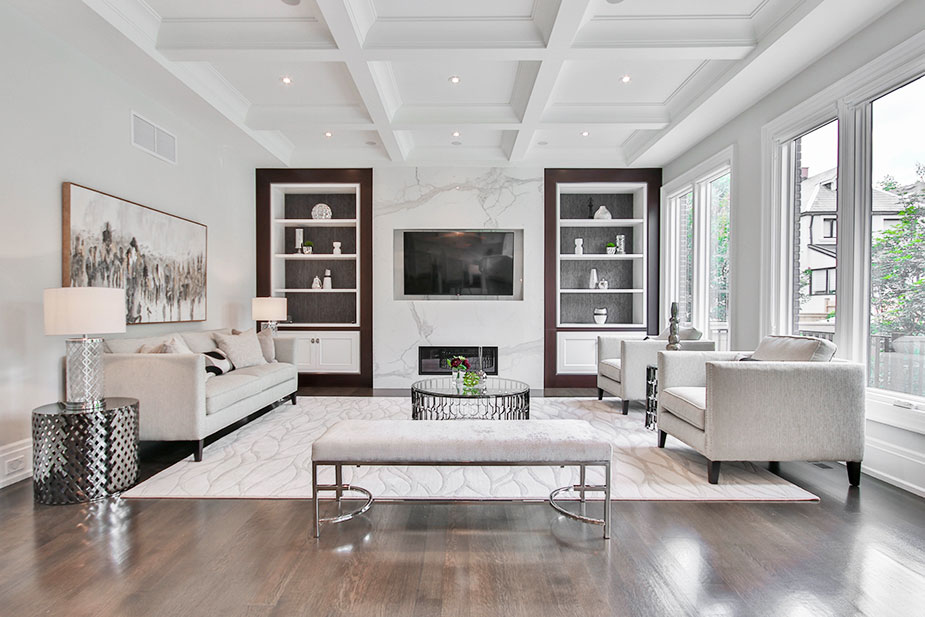
According to media gurus, decluttering our houses and living a simpler existence will enable us to deal with the overwhelming nature of the contemporary world. The word “minimalism” has been turned into a modern lifestyle buzzword. On the other hand, minimalist design has a long history in the fields of architecture, interior design, art, graphics, fashion, and almost every other aspect of design.
Prioritizing the essential is a key component of minimalist design. In order to reach a pure form of beauty, a minimalist structure, product, or interior design is reduced to its essential components, using few materials, neutral colours, basic shapes, and avoiding unnecessary adornment. Achieving this type of potent simplicity is anything but straightforward when designing a luxury home.
Throughout the past century, minimalist design has become more and more fashionable in modern design trends. Yet for every supporter, there is a maximalist detractor who condemns it as monotonous or sterile, devoid of creativity and emotion. Although minimalist architecture and product design can be affordable, environmentally friendly, and may ultimately contribute to the accessibility of good design, it has also come to be associated with a rarefied pursuit of the ideal object…a luxury that only a select few can afford.
History of Minimalism
In the 20th century, minimalist design arose as a response to, and rejection of, the ostentatious former aesthetics, such as flowery Victorian architecture and Abstract Expressionist painting.
According to some design historians, the roots of minimalism can be found in the simplified forms exemplified by the Dutch De Stijl movement from 1917 to the early 1930s. It is also widely acknowledged that Scandinavian design and traditional Japanese gardens and interiors have also had an influence.
In the 1960s, minimalist graphic design, fine art, theatre, and clothing became popular. Legendary figures in the field of product design, such as German industrial designer Dieter Rams, guided the design of commonplace items like desktop radios, calculators, and lacquerware. Rams’ maxim “less is better” ushered in a brand-new era of minimalist product design beginning in the middle of the 20th century. This laid the groundwork for the types of streamlined objects we live with today and continue to design for the future.
Over-accessorized, crammed-in interiors first gained popularity in the Victorian era and grew in popularity as a result of 20th-century consumer culture. This can now be replaced by luxurious interior design styles and home decor, including minimalist bedrooms, kitchens, living rooms, nurseries, and more.
Characteristics Of A Minimalistic Design
Minimalism has gained popularity in recent years, achieving superior design via simplicity in lines, forms, spaces, details, decorations, lighting, colours, and materiality. The minimalist style also demonstrates control and the thoughtful reduction and editing of areas to create a basic and clear setting.
Many people appreciate wide, airy spaces in their homes that allow the architecture, furniture, and other elements to breathe. The eye is drawn to minimalism because of the straightforward materials, details, and simplicity. We love the tranquillity and beauty that these rooms radiate.
There are certain characteristics of contemporary minimalist architecture. These qualities consist of:
Simplicity
The minimalist home plan must be easy-to-understand, effective, and basic. The regions and spaces become predictable because of minimalism’s clear and simple design. The distinguishing features of minimalist designs are straightforward forms and shapes, few internal walls, spacious and open floors, and reasonable storage places, as well as a focus on vistas and lighting.
Monochromatic
Minimalism entails avoiding vivid and strong hues in favour of neutral colour schemes like whites, creams, and greys. The idea of distilling anything down to its essentials is represented by these monochromatic colour choices.
Clean, Open, and Light-Filled Room
The minimalist style has always had these key elements, which are clean, open, and light-filled spaces. The minimalist design is quiet, appealing, and intriguing due to the use of a neutral colour scheme, light colour tones for the walls, clean contemporary details and furnishings, and uncluttered areas.
These rooms only include what is absolutely essential, which makes them airy and breathable. The room seems warm and inviting rather than sterile and dark, thanks to the abundance of natural light.
Only the Essentials
Eliminating waste is one of minimalism’s key tenets. To create a minimalist home design, one should first take an inventory all of their belongings. Choose items that are essential, based on necessity and a “clean” aesthetic, and remove the other items. You don’t need to be entirely practical to be minimalist. The minimalist philosophy is distinct. In minimalism, decoration and accessories should be tasteful but not overdone.
Because minimalist designs employ just a few essential items, they are constantly in style. There aren’t any messes or a lot of extra decorations or accessories. Additionally, it entails trimming unnecessary details and reducing information to the bare minimum. This elimination of potential distractions make it a great choice for minimalist office design, a place where uninterrupted work can take place.
Texture & Personality
A nice minimalist house design is possible with the strategic use of materials for visual interest, texture, and personality. Utilizing a tried and true method is crucial to achieving simplicity in the materials, shapes, and details. It has more to do with choosing order, tranquilly, purpose, and clarity than aggressively purging your home of everything you own. By concentrating on a small number of features, such as choosing the right rugs, minimalism is not necessarily about living with less; rather, it is about highlighting the colour, texture, and form of objects and environments.
Choose Harvey Kalles
The best realtors in Toronto on the Harvey Kalles team can assist you in finding the house of your dreams. We are one of the most well-known real estate companies in the Greater Toronto Area, and we are well-versed in the neighbourhoods of the city. Whether you want to sell your current home or locate your dream new home, our agents are here to assist you every step of the process.
